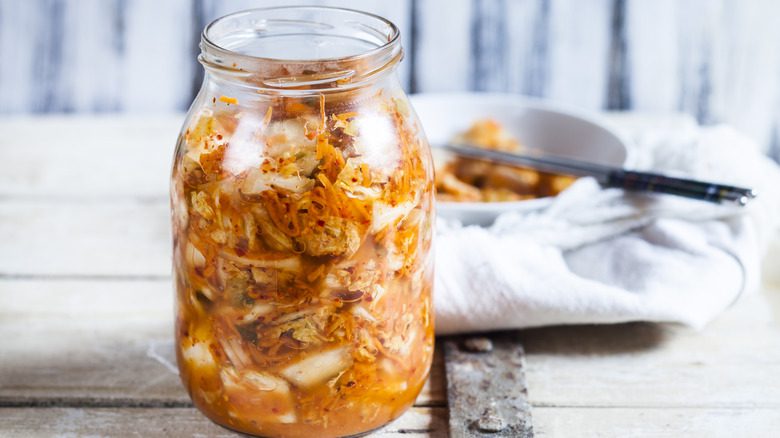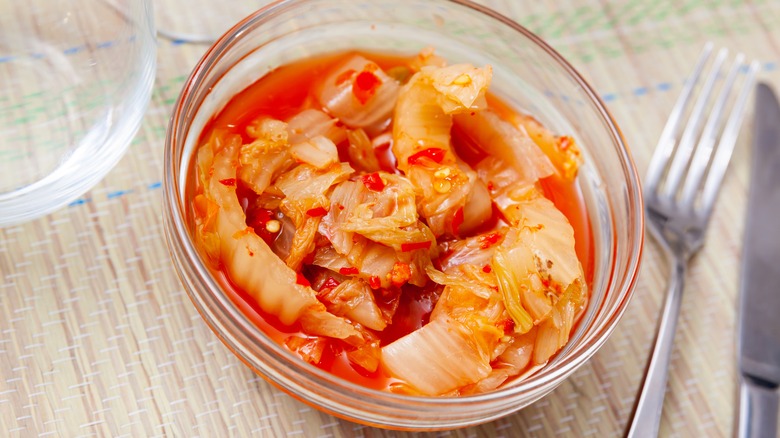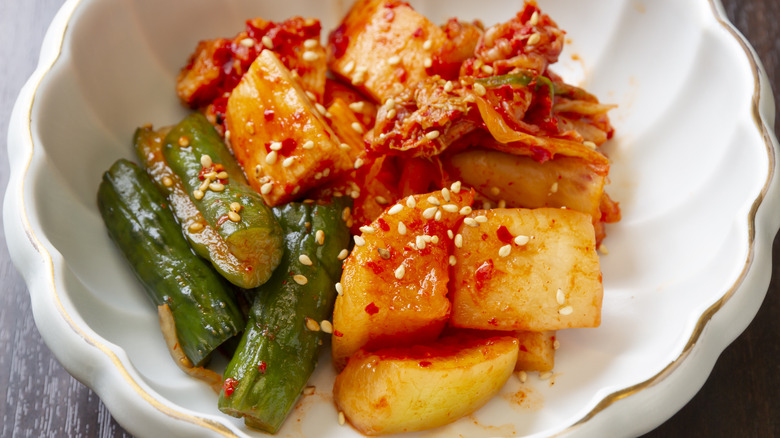The Best Way To Improve Store-Bought Kimchi Is Also The Easiest
Korean cuisine encompasses incredible dishes: a unique BBQ style, delicious bibimbap bowls, and a perfected corn dog. Yet one of the cuisine's greatest culinary treasures is kimchi, a fermented vegetable condiment bursting with flavor. Found in hundreds of varieties, the food possesses a unique palate with the help of allium aromatics, pepper paste, and oftentimes seafood additions.
However, a fundamental part of the food comes by way of the fermentation, a distinct process from pickling. The growth of beneficial bacteria enhances the flavor, and lends it nutritional benefits. In fact, it's a process that's still happening with store-bought kimchi. So if your purchased batch tastes a bit stale, enhance the flavor by letting the jar sit out at room temperature. Cold impedes bacterial action, but the warmer environs will kick-start fermentation once more, lending the batch some added sour and funk. The precise duration of extra fermentation depends on several factors, but generally a couple hours is all that's required.
Kimchi fermentation involves the purposeful growth of bacteria
Kimchi's magic is all in purposeful bacterial growth, which occurs by way of carefully selecting pickling ingredients in hygienic settings. Most classic kimchi recipes don't introduce bacteria, they instead use varieties found naturally on the vegetable. A saline solution draws sugar and starch out of the food, which activates the microorganisms and thereby creates the acidic environment of kimchi. Many processes take place simultaneously, with the temperature and oxygen content being especially important.
Processed kimchi slows this process by trapping oxygen, and lowering the temperature in the fridge. By taking a store-bought jar and opening the lid at room temperature, you're once again letting the fermentation take place. Make sure you conduct both steps, especially the lid loosening — a closed jar may even explode. It'll only take a couple of hours for you to notice carbonation, and an alteration in smell, a sign more fermentation has taken place.
The ecosystem created inside the jar is quite delicate, so avoid tampering with the pickled vegetables. Definitely don't add in extra ingredients, and you'll need to be cautious regarding the utensils used for handling. Make sure that the brine completely covers the vegetables, and don't leave the kimchi uncovered for extended periods of time. Prolonged exposure to air increases the risk of mold, and any foreign contaminants may carry dangerous bacteria. So, while enhancing kimchi is straightforward, adhere to precautions to avoid spoiling your batch.
Consider which kimchi to purchase for extended fermentation
Any kimchi with living cultures will be up for further pickling. Some brands choose to pasteurize their product to enhance shelf life. With such a variety, the hack of continuing fermentation won't work; so make sure to double check the label prior to purchase. Also take note that versions of unfermented kimchi exist, which are crafted for raw consumption. Alternatively, you'll also know the kimchi is no longer fermenting if it has been left out for several hours, and there's been no alteration in both smell and visible carbonation.
Additionally, you might want to consider the precise type of vegetable that's being pickled. While lesser known types in the U.S., a radish base (kkakdugi in Korean) and stuffed cucumber (oi sobagi) are kimchis known for their crunchiness. Fermenting them further will likely skew their zesty flavor, since such varieties are supposed to be consumed soon after pickling. The longest lasting kimchi variety is the popular napa cabbage (baechu) variety, so it's best for longer fermentation experiments.
Furthermore, if you're feeling extra cautious regarding illness, stick to fermenting vegan kimchi varieties. Seafood additions to kimchi are slightly more susceptible to spreading food illness, so you won't want to leave these out at room temperature for extended durations. Otherwise, ferment longer and discover a more aromatic kimchi awaiting.


